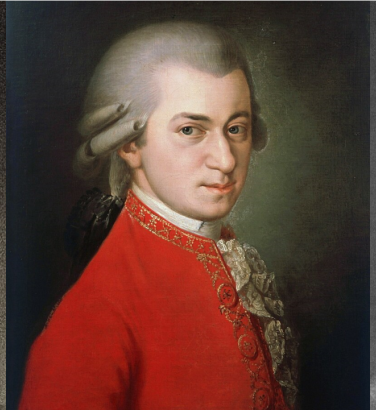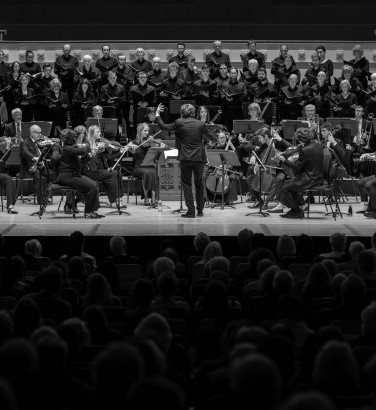
Visions of the afterlife: the Requiem Mass
20 Jan 2025
News Story
Death's head on the sarcophagus of Karl VI of Austria (detail)
In its original liturgical context, the function of the Requiem is essentially as a form of the Catholic mass specific to commemorating the dead. While both celebrate the congregation’s faith in God, the Requiem examines this in terms of what awaits the souls of the faithful in the afterlife.
That said, the Mass and the Requiem do share some of the same text. Other parts are tweaked to reflect the change of context (a longing for peace, for instance, becomes a prayer for the rest of the deceased), but for the most part, the words are very different – and depending on when a Requiem was written (and the religious views of its composer), they can vary considerably between one setting and the next.
The earliest Requiem to have survived – by the Renaissance composer Johannes Ockeghem, in the late 15th century – may actually not have reached us complete, but three of its five movements (the Introit, Kyrie and Offertorium) have remained a consistent presence since. Several other standard sections – the Sanctus, Benedictus and Agnus Dei among them – are generally included in later settings of this period, but the Sequence (or Dies Irae) took some time to establish itself as part of the standard text.
A vast section of the Requiem, this typically inspires composers to write some of their most terrifying music, aided considerably by instrumental accompaniment becoming a prerequisite as the orchestra became an established ensemble. Opening with the horror of the Last Judgement, the text culminates in a desperate prayer for mercy even as evildoers are condemned to eternal damnation. Mozart’s Requiem (written in 1791) provides one of the earliest and most effective Sequences, after which we have over a century’s worth of push and pull between markedly different takes on the text: at one end of the spectrum, high drama and at the other, something more intimate and consoling.
The 19th century also marked the point when performances of the Requiem started to move from the church to the concert hall, allowing composers to indulge their most extravagant ideas without worrying about fitting their music around the liturgy. The process had actually begun back in 1760, however, when François-Joseph Gossec had pushed at the limits of what was practical, writing a Requiem that lasted slightly over an hour. By far the most popular of these grand settings is Verdi’s: as might be expected from a composer primarily associated with opera, his Requiem is intensely dramatic, to the extent that countless others have been left languishing in the shadows. Dvořák’s is among those which might be otherwise better known, but in Berlioz, we have a Requiem (or Grande Messe des morts, to use its French title) whose sheer scale may actually work against it.
Let us start with the voices. There’s admittedly only one soloist, a tenor, but according to Berlioz’s instructions, he should be set against a choir of some 210 singers, with the addendum that “room permitting, the number of voices should be doubled or tripled.” This may, Berlioz continues, require additional instruments to balance this enormous chorus, but bear in mind that his Requiem requires four brass bands over and above the brass already in the main body of the orchestra, and you have some idea of the vast number of performers involved. We’ll leave you to imagine the kind of budget this would call for, but suffice it to say that this particular Requiem would probably be performed more frequently if it weren’t on such a ridiculously large – if very impressive! – scale.
As if to counter this, a number of composers appear deliberately to have conceived their own Requiems to be more intimate, with less emphasis on the terrors of Hell. In his German Requiem, Brahms goes as far as to forsake the original Latin text altogether in favour of words from the Lutheran Bible, concentrating largely on providing comfort to the bereaved. This set a precedent for later composers to look to other texts for their Requiem settings: Britten added the poetry of Wilfried Owen for an anti-war message in his War Requiem, while Howells’ includes two psalms alongside only the bare bones of the original Requiem text.
One of the most unusual of the smaller-scale Requiems is by Duruflé, whose combination of the text’s original plainchant settings (dating back to medieval times) with quiet pungent harmonies create a score that is ethereal and meditative. In this context, it’s no surprise that the composer should leave out all of the Sequence save its final words (Pie Jesu) – its drama being arguably transferred into the Libera Me – and end with In Paradisum, words expressing hope that the soul of the deceased may be welcomed into Heaven.
In this respect, there was a clear precedent in Fauré’s Requiem, which the SCO and SCO Chorus perform on 27-28 February. Often described as being the epitome of the intimate settings, it actually exists in a number of different orchestrations, all by the composer himself, who expanded the orchestra in each successive version.
The original line-up consisted of solo violin, harp, timpani, organ and lower strings, to which he first added two bassoons, four horns and two trumpets, and finally (for the work’s first publication) pairs of flutes and clarinets, along with three trombones and a full complement of violins. Each has its pros and cons, so the choice is largely down to personal preference – assuming, that is, that a small budget or performance space don’t come into play.
That said, some will prefer the work’s first iteration: it’s arresting by its very intimacy, with the organ and timpani on hand to add drama when needed. This is even truer of the latter revisions, with untold power courtesy of the brass (four horns!), while the extra woodwind and violins of the final version creating extra warmth. There’s no risk of the small scale nature of the music being lost as the orchestra grows in size either: those moments when a large ensemble suddenly drops to an impossibly hushed sound can be profoundly affecting.
Regardless of the orchestration, Fauré’s Requiem is an understandable favourite with performers and audiences alike. The very opening of the work encapsulates its appeal: the first note the orchestra plays is loud and long, fading as the choir emerges, seemingly from the mist, the voices providing a reassuring warmth to contrast with the starkness of the orchestra. There is drama, but never at the expense of a comforting vision of the afterlife – which remains a source of consolation in a world perhaps more in tune with secular humanism than the rigours of religious belief.

Fauré Requiem
Fauré's hushed prayer for the departed, from outstanding British baritone Roderick Williams, conductor Andrew Manze and the SCO Chorus.
Related Stories
![Three men, the first two in 18th century formal dress (one in black and white, one in a red coat), the last in an old photo, smoking]()
What is a sinfonia concertante?
17 March 2025
We delve into the history of a hybrid genre ...![]()
The SCO Chorus on music for Lent
10 March 2025
With Easter just around the corner, we delve into perhaps the richest (and often darkest) choral repertoire of all ...![]()
The bassoon concerto
3 March 2025
For the last article in our concerto series (for now), we turn to an instrument too often dismissed as the orchestra's resident joker.


